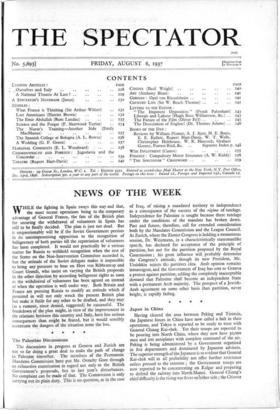Japan in China Having cleared the area between Peking and
Tientsin, the Japanese forces in China have now called a halt in their operations, and Tokyo is reported to be ready to treat with General Chiang Kai-shek. Yet their troops are reported to be pouring into North China, where they now have 30,000 men and 200 aeroplanes with complete command of the air. Peking is being administered by a Government organised in five departments and dominated by Japanese advisers. The superior strength of the Japanese is so evident that General Kai-shek will in all probability not offer further resistance unless pressed to the extreme ; the Government troops are now reported to be concentrating on Kalgar and preparing to defend the railway into North Shansi. General Chiang's chief difficulty is the rising war fever on either side ; the Chinese demand that the loss of North China be averted at all costs,while in Tokyo, where £18,000,000 has been voted for the costs of the war, it is asserted that no satisfactory solution can be found without the complete separation of North China from Nanking. Yet so long as the lull in the fighting continues one of those compromises characteristic of Oriental diplomacy is still possible and even probable. Japanese trade must inevitably suffer, for a boycott of Japanese goods, whether organised or unorganised, is inevitable. The Japanese civilian will thus be less equal than ever to meeting the intolerable financial demands of the army.







































 Previous page
Previous page